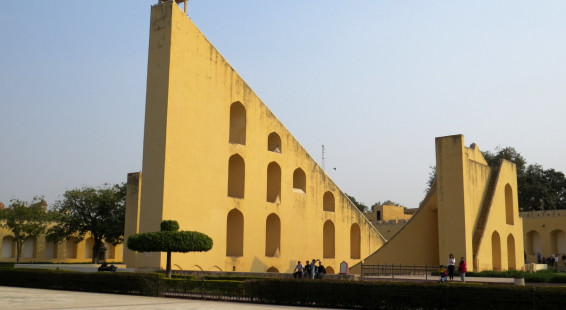
Jantar Mantar is a walled astronomical observation compound which adjoins the Royal Palace of Jaipur. It’s home to a collection of astronomical instruments — many massive — and was built in the eighteenth century by the Rajput king Sawai Jai Singh. The site was completed in 1734 and is an interesting hybrid of masonry, brass and science. Although it was abandoned in the 19th century and fell into disrepair, the site has been restored and is well preserved (the best in India). It is notable for being home to the world’s largest stone sundial, but I found all the instruments to be interesting.
Even a non-sophisticated or lay astronomer can have a sense of wonder at complexity of the instrumentation, and understand the principles of simple instruments like the sundials. It takes a true astronomer to comprehend how some of these instruments were used to track the location of major stars as the earth orbits, the determination of celestial altitudes and so on. The Jantar Mantar is a reminder of the astronomical skills of a scholarly prince at the end of the Mughal period. Jantar Mantar is a UNESCO World Heritage site.
The observatory consists of nineteen instruments for measuring time, predicting eclipses and such. A discussion of all the instruments is beyond the scope of this blog and the interested reader is referred to the site’s website. Some examples of these specially built structures include:
- Chakra Yantra consists of four semicircular arcs on which a gnomon casts a shadow, thereby giving the declination of the Sun at four specified times of the day.
- Jantar Mantar, Jaipur. Jaya Prakash Yantraconsists of two hemispherical bowl-based sundials with marked marble slabs that map an inverted image of sky. These structures allow observers to move inside the instrument, measure altitudes, hour angles and declinations.

Jantar Mantar, Jaipur. Jaya Prakash Yantra
- Laghu Samrat Yantra is the smaller sundial at the monument, easy to use and understand and quite precise but less accurate than much larger Vrihat Samrat Yantra.
- Nadi Valaya Yantra consists of two sundials on different faces of the instrument, the two faces represent northern and southern hemispheres. The accuracy of the instrument in measuring the time is less than a minute.
- Rashi Valaya Yantra is comprised by 12 dials that measure ecliptic coordinates of stars, planets and all 12 constellation systems.

Jantar Mantar — world’s largest sundail.
- Vrihat Samrat Yantra is the largest and most impressive structure at the site and the world’s largest sundial. It measures time in intervals of 2 seconds using shadow cast from the sunlight.
Not only is this site home to some great scientific instruments, it also has its own temple, the Hanuman Temple. If you are curious about things scientific, than a few hours spent visiting this site would be time well spent.
(Click on thumbnails to enlarge, then right arrow to advance slideshow)